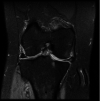Meniscal Root Tears: A Decade of Research on their Relevant Anatomy, Biomechanics, Diagnosis, and Treatment
- PMID: 35755791
- PMCID: PMC9194705
- DOI: 10.22038/ABJS.2021.60054.2958
Meniscal Root Tears: A Decade of Research on their Relevant Anatomy, Biomechanics, Diagnosis, and Treatment
Abstract
A foundational knowledge of the anatomy and biomechanics of meniscal root tears is warranted for proper repair of meniscal root tears and for preventing some of their commonly described iatrogenic causes. Meniscal root tears are defined as either a radial tear occurring within one cm of the root attachment site of the meniscus or a complete bony or soft tissue avulsion of the root attachment altogether. Meniscal root tears disrupt the protective biomechanical function of the native meniscus. Biomechanical analyses of the current techniques for meniscal root repair highlight the importance of restoring menisci to their correct anatomic orientation, thereby restoring their biomechanical function. A comprehensive understanding of the clinical and radiographic presentations of these injuries is critical to preventing their underdiagnosis. The poor long-term outcomes associated with conservative treatment measures, namely, ipsilateral compartment osteoarthritis, warrants the surgical repair of meniscal root tears whenever possible. While excellent patient-reported outcomes exist for the various surgical repair techniques, adherence to stringent post-operative rehabilitation protocols is critical for patients to avoid damaging the integrity of a repaired root. This review will focus on current concepts pertaining to the anatomy, biomechanics, diagnosis, treatment, and postoperative rehabilitation for meniscal root tears.
Keywords: Anterior cruciate ligament; Meniscus; Root.
Figures


















Similar articles
-
Meniscal Root Tears: Current Concepts Review.Arch Bone Jt Surg. 2018 Jul;6(4):250-259. Arch Bone Jt Surg. 2018. PMID: 30175171 Free PMC article. Review.
-
Arthroscopic meniscal repair with use of the outside-in technique.Instr Course Lect. 2000;49:195-206. Instr Course Lect. 2000. PMID: 10829175 Review.
-
Posterior Root Meniscal Tears: Preoperative, Intraoperative, and Postoperative Imaging for Transtibial Pullout Repair.Radiographics. 2016 Oct;36(6):1792-1806. doi: 10.1148/rg.2016160026. Radiographics. 2016. PMID: 27726749 Review.
-
Meniscal Root Tears: Identification and Repair.Am J Orthop (Belle Mead NJ). 2016 Mar-Apr;45(3):183-7. Am J Orthop (Belle Mead NJ). 2016. PMID: 27004274
-
Combined Meniscus Repair and Anterior Cruciate Ligament Reconstruction.Arthroscopy. 2022 Mar;38(3):670-672. doi: 10.1016/j.arthro.2022.01.003. Arthroscopy. 2022. PMID: 35248223
Cited by
-
The meniscal extrusion index is a reliable indirect sign of different meniscal lesion patterns: a classification based on percentage of meniscal extrusion.Knee Surg Sports Traumatol Arthrosc. 2023 Nov;31(11):5005-5011. doi: 10.1007/s00167-023-07525-6. Epub 2023 Aug 31. Knee Surg Sports Traumatol Arthrosc. 2023. PMID: 37653144 Free PMC article.
-
All-Inside Versus Inside-Out Suture Techniques in Athletes Undergoing Arthroscopic Meniscal Repair: A Systematic Review and Meta-analysis.Orthop J Sports Med. 2025 Aug 12;13(8):23259671251361488. doi: 10.1177/23259671251361488. eCollection 2025 Aug. Orthop J Sports Med. 2025. PMID: 40810129 Free PMC article.
-
Meniscus root tears: state of the art.Int Orthop. 2024 Apr;48(4):955-964. doi: 10.1007/s00264-024-06092-w. Epub 2024 Jan 23. Int Orthop. 2024. PMID: 38261073 Free PMC article. Review.
-
Arthroscopic Medial Meniscus Posterior Horn Direct Anchor Root Repair: Transtibial Approach With Knotless Adjustable Aperture Fixation.Arthrosc Tech. 2024 Feb 10;13(5):102934. doi: 10.1016/j.eats.2024.102934. eCollection 2024 May. Arthrosc Tech. 2024. PMID: 38835457 Free PMC article.
-
Diagnosis and Treatment Strategies of Meniscus Root Tears: A Scoping Review.Orthop J Sports Med. 2024 Nov 1;12(11):23259671241283962. doi: 10.1177/23259671241283962. eCollection 2024 Nov. Orthop J Sports Med. 2024. PMID: 39493310 Free PMC article.
References
-
- LaPrade RF, Floyd ER, Carlson GB, Moatshe G, Chahla J, Monson JK. Meniscal root tears: Solving the silent epidemic. Journal of Arthroscopic Surgery and Sports Medicine. 2021;2(1):47–57.
-
- LaPrade CM, Jansson KS, Dornan G, Smith SD, Wijdicks CA, LaPrade RF. Altered tibiofemoral contact mechanics due to lateral meniscus posterior horn root avulsions and radial tears can be restored with in situ pull-out suture repairs. J Bone Joint Surg Am. 2014;96(6):471–9. - PubMed
-
- Matheny LM, Ockuly AC, Steadman JR, LaPrade RF. Posterior meniscus root tears: associated pathologies to assist as diagnostic tools. Knee Surg Sports Traumatol Arthrosc. 2015;23(10):3127–31. - PubMed
Publication types
LinkOut - more resources
Full Text Sources
